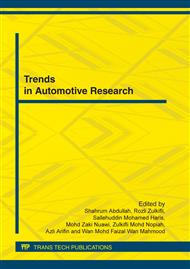p.155
p.160
p.165
p.170
p.175
p.182
p.187
p.192
p.197
Wet Sump Design for a FSAE Racing Car
Abstract:
The problem statement consisted of designing a Wet Sump Lubrication system for Formula Manipal, Manipal Institute of Technology's FSAE racing team. The team uses a 2003 specification Honda CBR 600RR motorcycle engine to power the rear wheels by means of a chain drive and a limited slip differential. Packaging and performance constraints meant that the stock oil pan could not be retained. It was thus proposed to design and manufacture a custom wet sump oil pan and validate it by testing. The goal was to build a lubrication system which worked flawlessly in a racing environment including acceleration, braking and cornering. This was realized by innovatively placing baffles and a windage tray in the oil pan. At the same time, it was important to reduce the height of the oil pan so as to allow the engine to be mounted lower in the chassis, facilitate better packaging and improve the dynamic performance of the car.
Info:
Periodical:
Pages:
175-181
Citation:
Online since:
April 2012
Authors:
Keywords:
Price:
Сopyright:
© 2012 Trans Tech Publications Ltd. All Rights Reserved
Share:
Citation:


